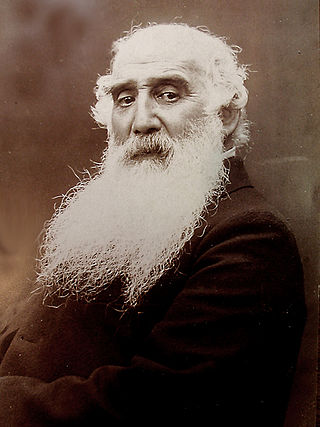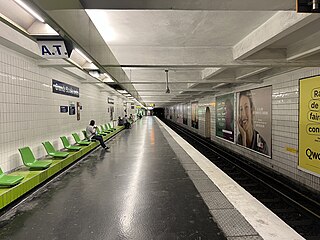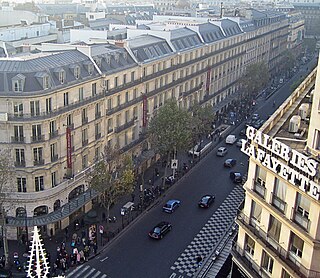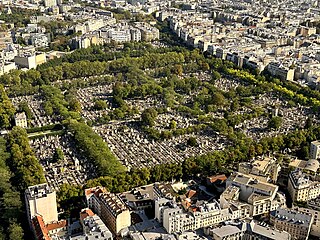
Jacob Abraham Camille Pissarro was a Danish-French Impressionist and Neo-Impressionist painter born on the island of St Thomas. His importance resides in his contributions to both Impressionism and Post-Impressionism. Pissarro studied from great forerunners, including Gustave Courbet and Jean-Baptiste-Camille Corot. He later studied and worked alongside Georges Seurat and Paul Signac when he took on the Neo-Impressionist style at the age of 54.

Montmartre is a large hill in Paris's northern 18th arrondissement. It is 130 m (430 ft) high and gives its name to the surrounding district, part of the Right Bank. Montmartre is primarily known for its artistic history, for the white-domed Basilica of the Sacré-Cœur on its summit, and as a nightclub district.

The Basilica of Sacré Coeur de Montmartre, commonly known as Sacré-Cœur Basilica and often simply Sacré-Cœur, is a Catholic church and minor basilica in Paris dedicated to the Sacred Heart of Jesus. It was formally approved as a national historic monument by the National Commission of Patrimony and Architecture on December 8, 2022.

Anvers is a station on Line 2 of the Paris Métro. It is located in Montmartre, on the border of the 9th and the 18th arrondissements.

Grands Boulevards, formerly named Rue Montmartre (1931–1998), is a station on Lines 8 and 9 of the Paris Métro. In 2019, it was the 44th busiest station of the Métro network, with 6,807,424 yearly users.
The Moulin de la Galette is a windmill and associated businesses situated near the top of the district of Montmartre in Paris. Since the 17th century the windmill has been known for more than just its milling capabilities. Nineteenth-century owners and millers, the Debray family, made a brown bread, galette, which became popular and thus the name of the windmill and its businesses, which have included a famous guinguette and restaurant. In the 19th century, Le Moulin de la Galette represented diversion for Parisians seeking entertainment, a glass of wine and bread made from flour ground by the windmill. Artists, such as Renoir, van Gogh, Ramón Casas and Pissarro have immortalized Le Moulin de la Galette; likely the most notable was Renoir's festive painting, Bal du moulin de la Galette.

The Boulevard Haussmann, 2.53-kilometre (1.57 mi) long from the 8th to the 9th arrondissement, is one of the wide tree-lined boulevards created in Paris by Napoleon III, under the direction of his Prefect of the Seine, Baron Haussmann.

Le Chat Noir was a 19th century entertainment establishment in the bohemian Montmartre district of Paris. It was opened on 18 November 1881 at 84 Boulevard de Rochechouart by impresario Rodolphe Salis, and closed in 1897 not long after Salis' death.

Élysée Montmartre is a music venue located at 72 Boulevard de Rochechouart, Paris, France. It opened in 1807, burned down in 2011, reopened in 2016, and has a capacity of 1,380 patrons. The nearest métro station is Anvers.

The Cirque Medrano is a French circus that was located at 63 Boulevard de Rochechouart, at the corner of rue des Martyrs, in the 18th arrondissement at the edge of Montmartre in Paris. It was originally called Cirque Fernando. The title "Cirque Medrano" is still active today: it is now a successful French traveling circus.

The Boulevards of Paris are boulevards which form an important part of the urban landscape of Paris. The boulevards were constructed in several phases by central government initiative as infrastructure improvements, but are very much associated with strolling and leisurely enjoyment in the minds of Parisians.

Le Moulin de la Galette is the title of several paintings made by Vincent van Gogh in 1886 of a windmill, the Moulin de la Galette, which was near Van Gogh and his brother Theo's apartment in Montmartre. The owners of the windmill maximized the view on the butte overlooking Paris, creating a terrace for viewing and a dance hall for entertainment.

The Boulevard de la Madeleine is one of the four 'grands boulevards' of Paris, France, a chain of roads running east–west that includes the boulevard de la Madeleine, the boulevard des Capucines, the boulevard des Italiens and the boulevard Montmartre.

Montparnasse Cemetery is a cemetery in the Montparnasse quarter of Paris, in the city's 14th arrondissement. The cemetery is roughly 47 acres and is the second largest cemetery in Paris. The cemetery has over 35,000 graves and approximately a thousand people are buried here each year.

Louis Rodolphe Salis was the creator, host and owner of the Le Chat Noir cabaret. With this establishment Salis is remembered as the creator of the modern cabaret: a nightclub where the patrons could sit at tables with alcoholic drinks and enjoy variety acts on a stage, introduced by a master of ceremonies who interacted with the audience.

The Montmartre paintings are a group of works that Vincent van Gogh created in 1886 and 1887 of the Paris district of Montmartre while living there, at 54 Rue Lepic, with his brother Theo. Rather than capture urban settings in Paris, van Gogh preferred pastoral scenes, such as Montmartre and Asnières in the northwest suburbs. Of the two years in Paris, the work from 1886 often has the dark, somber tones of his early works from the Netherlands and Brussels. By the spring of 1887, van Gogh embraced use of color and light and created his own brushstroke techniques based upon Impressionism and Pointillism. The works in the series provide examples of his work during that period of time and the progression he made as an artist.

Boulevard Montmartre, Mardi Gras by Camille Pissarro currently resides in the permanent exhibition at the Armand Hammer Museum in Los Angeles, California. This work is part of a series of fourteen paintings depicting different times of the day and seasons of the Boulevard Montmartre in Paris. Camille Pissarro is known as the "Father of Impression" for his "teacher's eye" of drawing what he saw in front of him.

The Passage Jouffroy is a covered passages of Paris, France, located in the 9th arrondissement. It runs between the Boulevard Montmartre to the south and the Rue de la Grange-Batelière to the north.

Cabaret de l'Enfer was a famous cabaret in Montmartre, founded in November 1892 by Antonin Alexander and demolished in 1950 to allow for the expansion of a Monoprix supermarket. The Cabaret de L'Enfer was the counterpart to The Cabaret du Ciel, another cabaret which shared the same address on the Boulevard de Clichy. Antonin Alexander was the creator, director, and host of the twin ventures.



















